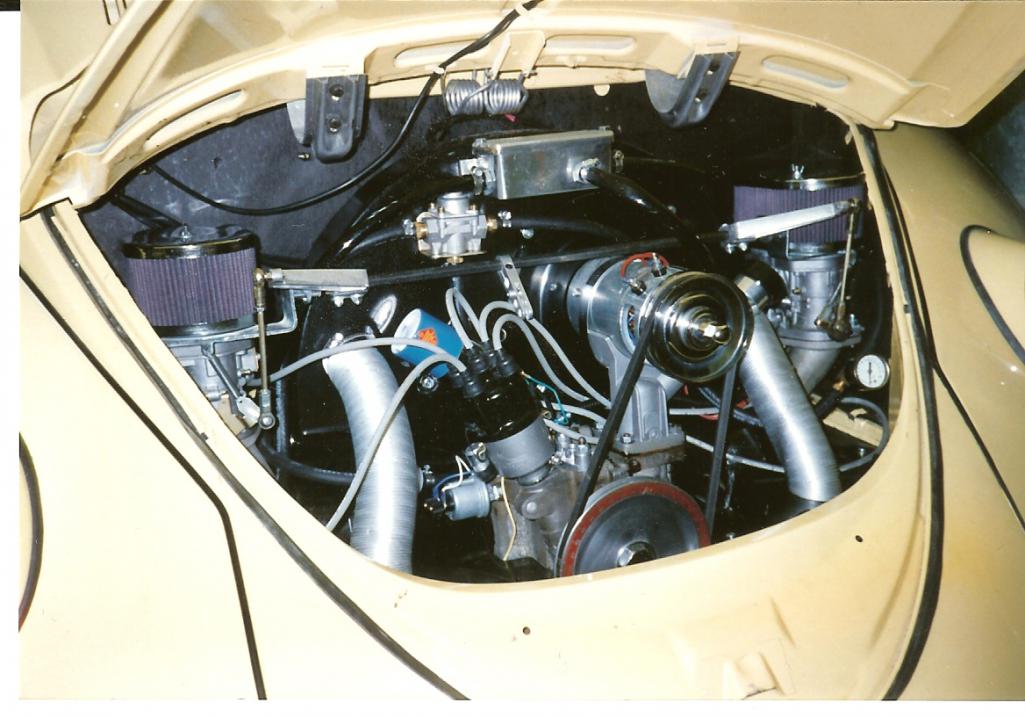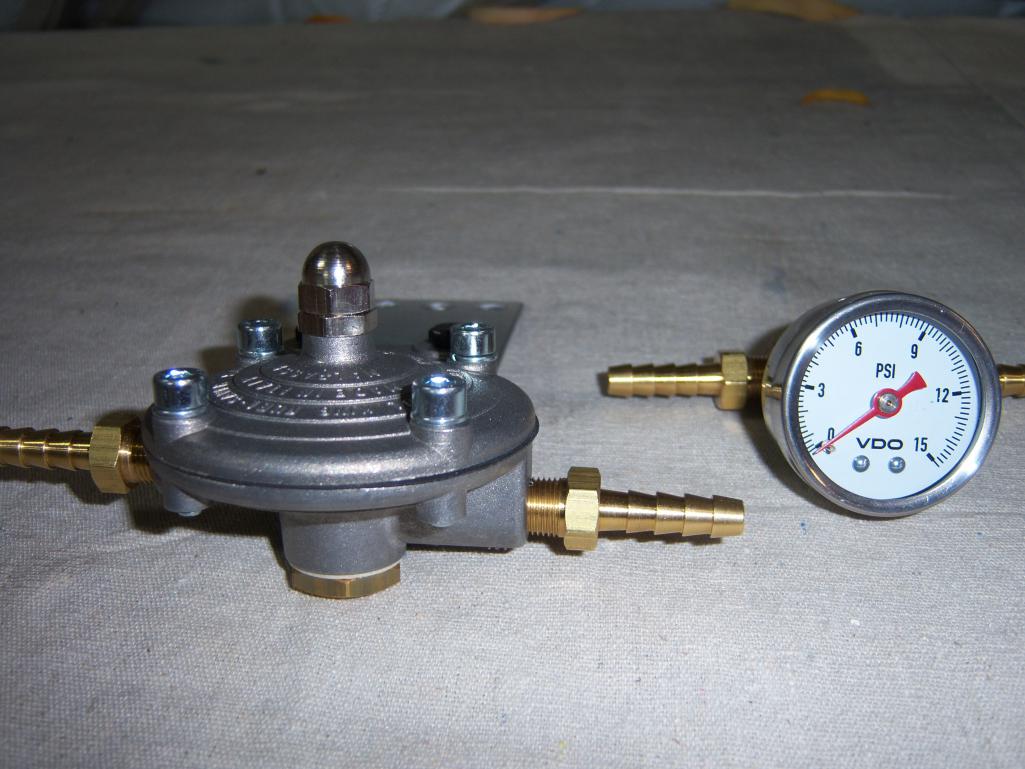|
|

|
Porsche, and the Porsche crest are registered trademarks of Dr. Ing. h.c. F. Porsche AG.
This site is not affiliated with Porsche in any way. Its only purpose is to provide an online forum for car enthusiasts. All other trademarks are property of their respective owners. |
|
|
| North Coast Jim |
 Nov 30 2016, 05:11 PM Nov 30 2016, 05:11 PM
Post
#1
|
|
Member   Group: Members Posts: 340 Joined: 11-December 15 From: Northern Ohio Member No.: 19,450 Region Association: MidAtlantic Region 
|
My new 2056 engine running 44IDFs has now about a 40 miles on it. So cool to have this car back on the road after 25 years. Runs way to rich with a 160 main, 175 air correction, 60 Idle jets and a 36mm venturi. Continue to have a problem with popping through the carburetor at partial throttle. Fuel pump is the Carter rotary with inline filter along with their SS lines through the tunnel purchased from Tangerine Racing. Engine builder wants me to install a fuel pressure regulator to eliminate this as a variable. The jetting exercise can come afterward. I bought an Italian made "Petrol King" diaphram regulator with single outet. Will hook up serially the pump/ filter/ regulator / guage than "T" off to the two carbs. I'd like to hard mount this device but where ?? To the body or to the engine ?? I'm sure this has been done before. Any suggestions. Pics would also help. Thanks World
|
  |
Replies(1 - 9)
| SirAndy |
 Nov 30 2016, 06:47 PM Nov 30 2016, 06:47 PM
Post
#2
|
|
Resident German                          Group: Admin Posts: 42,258 Joined: 21-January 03 From: Oakland, Kalifornia Member No.: 179 Region Association: Northern California |
What's the pressure on your fuel pump?
When i had my carbed 2056, the CB rotary pump put out 3.5psi, there was no need for a pressure regulator. If your pressure is too high (from the sound of it), you need to install it between the pump and the first carb. I would install it as close to the pump as possible. Also of note, you might want to put the filter behind the regulator or before the pump unless the filter is designed for high pressure. (IMG:style_emoticons/default/popcorn[1].gif) |
| jmill |
 Nov 30 2016, 06:48 PM Nov 30 2016, 06:48 PM
Post
#3
|
|
Green Hornet     Group: Members Posts: 2,449 Joined: 9-May 08 From: Racine, Wisconsin Member No.: 9,038 Region Association: Upper MidWest |
The carter is internally regulated. Buy a gauge not a regulator. Your AC jet is way too small, idle and main are too big with what I suspect are vents that are too large. Popping at part throttle is lean transition due to vents that are too large.
On a side note, check float level. A low level will create a lean pop. What ET do you have? I assume F11. There are other choices to help with your lean transition (F7). |
| SirAndy |
 Nov 30 2016, 09:13 PM Nov 30 2016, 09:13 PM
Post
#4
|
|
Resident German                          Group: Admin Posts: 42,258 Joined: 21-January 03 From: Oakland, Kalifornia Member No.: 179 Region Association: Northern California |
Popping at part throttle is lean transition due to vents that are too large. (IMG:style_emoticons/default/agree.gif) I ran 32mm venturis on my 2056. Anything bigger than that and it would fall flat on its nose coming off idle. (IMG:style_emoticons/default/shades.gif) |
| IronHillRestorations |
 Dec 1 2016, 07:36 AM Dec 1 2016, 07:36 AM
Post
#5
|
|
I. I. R. C.      Group: Members Posts: 6,835 Joined: 18-March 03 From: West TN Member No.: 439 Region Association: None 
|
I'll pile on the "venturis are too large" argument. They might be the choice for a race car that lives above 4000 rpm all day.
Popping through the carbs is either a lean condition or incorrect ignition timing. All this is not to say you don't have the wrong fuel pressure. Check it with a fuel pressure gauge. If you need one, I have a nice one that also functions as a T for $40 without fittings. Also there are two types of fuel pressure regulators, bypass and blocking. Bypass is what you use when you make a loop with a return line, where the regulator goes after the loop, and to the return line. Blocking is used before the carbs. |
| pbanders |
 Dec 1 2016, 09:26 AM Dec 1 2016, 09:26 AM
Post
#6
|
|
Senior Member    Group: Members Posts: 943 Joined: 11-June 03 From: Phoenix, AZ Member No.: 805 |
I'll pile on the "venturis are too large" argument. They might be the choice for a race car that lives above 4000 rpm all day. Popping through the carbs is either a lean condition or incorrect ignition timing. All this is not to say you don't have the wrong fuel pressure. Check it with a fuel pressure gauge. If you need one, I have a nice one that also functions as a T for $40 without fittings. Also there are two types of fuel pressure regulators, bypass and blocking. Bypass is what you use when you make a loop with a return line, where the regulator goes after the loop, and to the return line. Blocking is used before the carbs. EDITED: talking about stuff I don't know any more, sorry... |
| jmill |
 Dec 1 2016, 10:30 AM Dec 1 2016, 10:30 AM
Post
#7
|
|
Green Hornet     Group: Members Posts: 2,449 Joined: 9-May 08 From: Racine, Wisconsin Member No.: 9,038 Region Association: Upper MidWest |
If you had a lean pop at the top end of a hard pull I'd suspect low fuel pressure/volume problem.
If you lift the needle valve off the seat and you spill fuel out of the carb I'd suspect a high pressure fuel problem. Part throttle lean pops are because you get off the idle jets prior to the main jets coming in. Solutions 1- float level is low which delays the mains from coming in. 2 - vents too large which delay mains from coming in. 3 - ET tube selection 4 - accelerator pump jets plugged - low volume Idle jets require a pressure differential above and below the butterfly to draw fuel. When the butterfly opens, that DP decreases until there is no DP. The main jets then require enough air velocity through the vents to create a pressure differential to draw fuel through them from the fuel wells (Bernoulli's principle). The larger the vent the lower the air velocity and the lower the DP. The name of the game is to have the mains come in at the same time that the idles go out. |
| jmill |
 Dec 1 2016, 11:22 AM Dec 1 2016, 11:22 AM
Post
#8
|
|
Green Hornet     Group: Members Posts: 2,449 Joined: 9-May 08 From: Racine, Wisconsin Member No.: 9,038 Region Association: Upper MidWest |
The pic below is of my old bug that had 44's with 36mm vents. It was a 1914cc engine that had Chevy 2.02 intake valves. I needed the large vents to reach 7K RPM. I built it for 8K RPM but never had the guts to spin it that fast and doubt I had the carbs for it. 48 IDA's were an option but scarce at the time.
I did lots of tuning to make them work. It took large accelerator pump jets, F7 ET's and float levels on the fine line of being too high. BTW it got about 6 mpg. Why go through that mess when you're not drag racing it. Note the Holley 1 in 2 out regulator and fuel pressure gauge. I had a Holley blue pump putting out 14 psi and needed to drop pressure to avoid lifting the float needle valves. Attached thumbnail(s) 
|
| North Coast Jim |
 Dec 2 2016, 08:53 AM Dec 2 2016, 08:53 AM
Post
#9
|
|
Member   Group: Members Posts: 340 Joined: 11-December 15 From: Northern Ohio Member No.: 19,450 Region Association: MidAtlantic Region 
|
My new 2056 engine running 44IDFs has now about a 40 miles on it. So cool to have this car back on the road after 25 years. Runs way to rich with a 160 main, 175 air correction, 60 Idle jets and a 36mm venturi. Continue to have a problem with popping through the carburetor at partial throttle. Fuel pump is the Carter rotary with inline filter along with their SS lines through the tunnel purchased from Tangerine Racing. Engine builder wants me to install a fuel pressure regulator to eliminate this as a variable. The jetting exercise can come afterward. I bought an Italian made "Petrol King" diaphram regulator with single outet. Will hook up serially the pump/ filter/ regulator / guage than "T" off to the two carbs. I'd like to hard mount this device but where ?? To the body or to the engine ?? I'm sure this has been done before. Any suggestions. Pics would also help. Thanks World Thanks all for the valuable input. Decided to do the following. I'll put in the fuel pressure gauge temporarily to ensure we have the proper pressure. If required I'll install the pressure regulator. See pic.  Also I've ordered the following carb updates, 32mm venturis, 145 mains and a 200 air correction jets. I have an assortment of idle jets and will start at 50. Will keep you all posted on progress. This may take a while as the snow season is fast approaching the North Coast. Lastly if I was to add an A/F system what would I have to do to incorporate this into the engine. |
| jmill |
 Dec 2 2016, 09:46 AM Dec 2 2016, 09:46 AM
Post
#10
|
|
Green Hornet     Group: Members Posts: 2,449 Joined: 9-May 08 From: Racine, Wisconsin Member No.: 9,038 Region Association: Upper MidWest |
This is where I start for engines in 2.0 - 2.5 liters with a 2.00 AC jet. Yes, they can fall out of the range below but chances are good that it'll be close to it. There are a ton of variables. ET also plays a big factor.
32mm vent = 115 to 130 34mm vent = 125 to 140 36mm vent = 135 to 165 You may find that the 145 mains are too large for 32mm vents. The smaller the vent, the higher the air velocity passing through it. The higher the velocity the lower the pressure. The lower the pressure the more fuel that will be drawn from the mains. |
  |
1 User(s) are reading this topic (1 Guests and 0 Anonymous Users)
0 Members:

|
Lo-Fi Version | Time is now: 19th July 2025 - 06:58 AM |
Invision Power Board
v9.1.4 © 2025 IPS, Inc.








